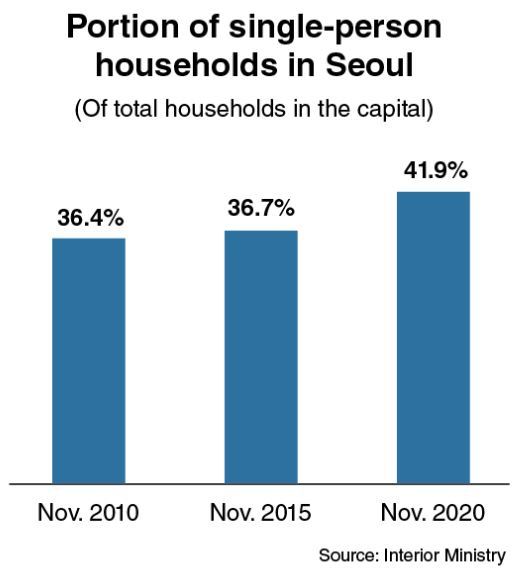[News Focus] Korea’s single-person households top 9 million
By Kim Yon-sePublished : Dec. 13, 2020 - 01:02

SEJONG -- The number of single-person households in South Korea has surpassed the 9 million mark for the first time since the nation started compiling the data.
According to the Ministry of Interior and Safety, the tally for single-person households came to 9.009 million as of November, which made up 39.1 percent of the total 23.03 million households nationwide.
The figure contrasts with 34.4 percent (7.23 million), posted five years earlier in November 2015 and 33.3 percent (6.61 million) a decade earlier in November 2010.
Demographic researchers say that the sharp increase of the portion of people residing alone was mainly attributed to falling marriage rates; climbing divorce rates; and rising tally for female seniors, whose average lifespan is longer than that of their husbands.
In the tallies in terms of family members, the single-person households far outnumbered others -- two-member households with 5.37 million, three-member with 4.01 million and four-member with 3.52 million last month.

Of the 4.41 million households in the capital, the number of Seoulites residing alone posted 1.85 million in November, taking up a historic 41.9 percent. This far outstripped two-member households at 950,000, those with three members at 760,000 and four members at 650,000.
Given that the portion was 36.7 percent (1.53 million) in November 2015 and 36.4 percent (1.51 million) in November 2010, single-person households have markedly increased in Seoul in recent years.
Seoul topped the list among the eight major cities in the relevant comparison. Daejeon was next with 39.4 percent, whose growth rate in the percentage of single-person households over the past 10 years was fastest -- about an 11 percentage point -- among the eight major cities.
Busan ranked third with 38.5 percent, followed by Gwangju with 38 percent, Daegu with 36.4 percent and Incheon with 36.2 percent. Ulsan and Sejong posted relatively low proportions at 33.4 percent and 33.1 percent, respectively.
A government official attributed Seoul’s highest ranking among the eight cities to the number of young, unmarried people in their 20s and 30s working or studying in the capital amid low marriage and fertility rates.
An analyst in Seoul said a recent core factor is that more and more young people in their 20s are living apart from their parents, as shown in resident registration data.
“It is thought that the resident-registration separation was targeted for better positions in the state-led apartment subscriptions, under which the young generation become independent householders from formerly household members,” he said.
As for all 17 major areas, or eight cities and nine provinces, South Jeolla Province posted the highest, 44.7 percent, in the portion of single-member households.
“As for figures held by some provinces, a growing number of older people are residing alone in rural areas after losing a spouse and with their married children having moved to metropolitan cities,” a government official said.
In November 2010, four-member households -- Korea’s typical family type since mid-1970s -- took up 21.3 percent of the total households across the country. It was the second-greatest by proportion, trailing single-person households whose percentage out of the total households posted 33.3 percent.
The third- and fourth-largest were two-member (19 percent) and three-member (18.3 percent) households 10 years earlier.
In contrast, in November 2020, the percentage of four-member households slid to fourth place with their portion standing at only 15.3 percent out of the total last month.
By Kim Yon-se (kys@heraldcorp.com)
According to the Ministry of Interior and Safety, the tally for single-person households came to 9.009 million as of November, which made up 39.1 percent of the total 23.03 million households nationwide.
The figure contrasts with 34.4 percent (7.23 million), posted five years earlier in November 2015 and 33.3 percent (6.61 million) a decade earlier in November 2010.
Demographic researchers say that the sharp increase of the portion of people residing alone was mainly attributed to falling marriage rates; climbing divorce rates; and rising tally for female seniors, whose average lifespan is longer than that of their husbands.
In the tallies in terms of family members, the single-person households far outnumbered others -- two-member households with 5.37 million, three-member with 4.01 million and four-member with 3.52 million last month.

Of the 4.41 million households in the capital, the number of Seoulites residing alone posted 1.85 million in November, taking up a historic 41.9 percent. This far outstripped two-member households at 950,000, those with three members at 760,000 and four members at 650,000.
Given that the portion was 36.7 percent (1.53 million) in November 2015 and 36.4 percent (1.51 million) in November 2010, single-person households have markedly increased in Seoul in recent years.
Seoul topped the list among the eight major cities in the relevant comparison. Daejeon was next with 39.4 percent, whose growth rate in the percentage of single-person households over the past 10 years was fastest -- about an 11 percentage point -- among the eight major cities.
Busan ranked third with 38.5 percent, followed by Gwangju with 38 percent, Daegu with 36.4 percent and Incheon with 36.2 percent. Ulsan and Sejong posted relatively low proportions at 33.4 percent and 33.1 percent, respectively.
A government official attributed Seoul’s highest ranking among the eight cities to the number of young, unmarried people in their 20s and 30s working or studying in the capital amid low marriage and fertility rates.
An analyst in Seoul said a recent core factor is that more and more young people in their 20s are living apart from their parents, as shown in resident registration data.
“It is thought that the resident-registration separation was targeted for better positions in the state-led apartment subscriptions, under which the young generation become independent householders from formerly household members,” he said.
As for all 17 major areas, or eight cities and nine provinces, South Jeolla Province posted the highest, 44.7 percent, in the portion of single-member households.
“As for figures held by some provinces, a growing number of older people are residing alone in rural areas after losing a spouse and with their married children having moved to metropolitan cities,” a government official said.
In November 2010, four-member households -- Korea’s typical family type since mid-1970s -- took up 21.3 percent of the total households across the country. It was the second-greatest by proportion, trailing single-person households whose percentage out of the total households posted 33.3 percent.
The third- and fourth-largest were two-member (19 percent) and three-member (18.3 percent) households 10 years earlier.
In contrast, in November 2020, the percentage of four-member households slid to fourth place with their portion standing at only 15.3 percent out of the total last month.
By Kim Yon-se (kys@heraldcorp.com)







![[Hello India] Hyundai Motor vows to boost 'clean mobility' in India](http://res.heraldm.com/phpwas/restmb_idxmake.php?idx=644&simg=/content/image/2024/04/25/20240425050672_0.jpg&u=)










